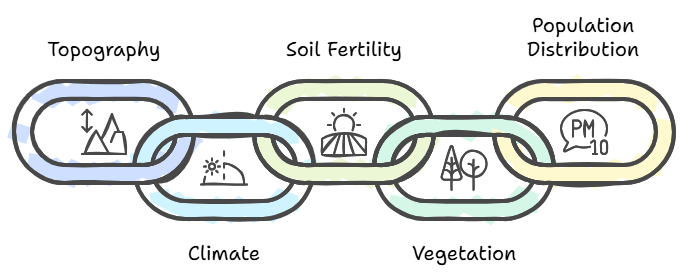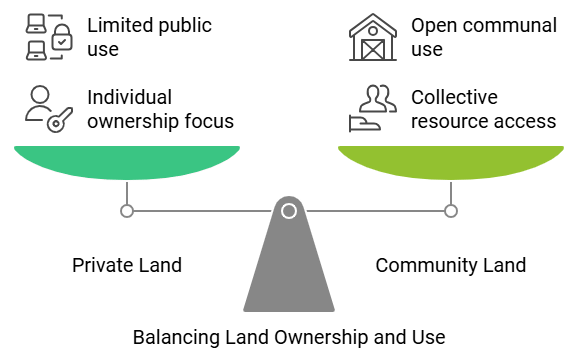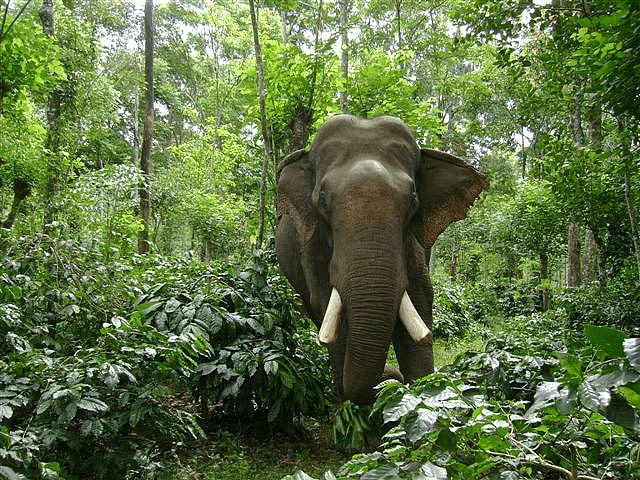Class 8 Geography Chapter 2 Notes - Land, Soil, Water, Natural Vegetation and Wildlife Resources Resources
| Table of contents |

|
| Land |

|
| Factors Affecting the Habitability |

|
| Soil |

|
| Water |

|
| Natural Vegetation and Wildlife |

|
| Factors Affecting Soil Formation |

|
| Words that Matter |

|
The quality of land, soil, water, natural vegetation, animals, and the usage of technology are important factors in controlling the standard and way of life people lead at a particular place.
Land
The land covers just about 30% of the surface of the earth. It is not suitable for living everywhere, because of a lot of additional conditions that affect life. Parts of land not suitable for a living are said to be inhabitable while the ones where people live are said to be habitable.
Factors Affecting the Habitability

- Some factors affecting the habitability of a place are topography, height from sea level, climate, fertility of the soil, vegetation, etc.
- People cannot live in dense forests or in deserts. They cannot live on high slopes in mountainous areas, or in low-lying areas where there is the possibility of floods and waterlogging.
- Plains and river valleys are the places where agriculture is suited, so most of the world population lives in such areas, and these areas are heavily populated.
Uses of Land
- The purpose and way in which land is used is called land use.
- Land use may be for agriculture, forestry, mining, building houses, roads, setting up of industries, or various other purposes.
- Factors determining the land use include physical factors like topography, availability of water, climate, minerals, soil, etc, or human factors like demography (population pattern), technology and education.
Important Facts:
- Land usually has ownership. It may be private land or community land. Private land is owned by an individual or group of individuals, like a house is private land. Community land is meant for use by anyone in society, like land for the collection of fodder, fruits, etc. Community lands are also called common property resources.

- Since the population is always growing at a fast pace, the demand for land is increasing, whereas the availability of land is limited.
- Land degradation, landslides, soil erosion, desertification are major threats to the environment.
- Due to the huge demand for land, people have also started reducing forest cover in order to make them habitable. This has resulted in deforestation. Afforestation (growing trees), regulated use of chemical pesticide and checking overgrazing by animals are some general methods to conserve these valuable natural resources.
Soil
- The word soil refers to the thin layer of grainy substance covering the surface of the earth. This layer is made of organic matter, minerals and weathered rocks. The long process of weathering is responsible for the formation of soil.

- Weathering refers to the breaking up and decay of exposed rocks. This breaking up and decay are caused by temperature fluctuations, frost action, plants, animals and even human activity. Due to weathering, in thousands of years, the soil is formed.
- The nature of the parent rock and climatic factors are major factors of soil formation. Other factors include topography, the role of organic material and time taken for the composition of soil formation.
- Soil erosion and depletion pose major threats to the quality and resourcefulness of soil. Degradation takes place by both human and natural factors. Deforestation, overgrazing, overuse of chemical fertilisers or pesticides, rain wash, landslides and floods lead to degradation of soil.
- Mulching is the process of covering the bare ground between plants with a layer of organic matter like straw. This helps in retaining soil moisture.
- Farmers use stones, grass and soil to build barriers along contours. Trenches are made in front of them to collect water.
- Terrace farming is the method of farming in which broad flat steps or terraces are made on the steep slopes so that flat surfaces are available to grow crops. This helps in controlling soil erosion.
- In intercropping, different crops are grown in alternate rows and are sown at different times to protect the soil from being washed away by rain.
- Ploughing parallel to the contours of a hill slope to form a natural barrier for water to flow down a slope is called contour ploughing.
- Rows of trees are planted in certain areas to check wind movement. Such rows are called shelterbelts. These trees are supposed to bind the soil, thus preventing them from being eroded away easily.
Water
- Water covers about 75% of the surface of the earth. Therefore, the earth is called the water planet. Ocean water is saline and not fit for human consumption. Freshwater is just about 2.7% of the total water. So freshwater is very scarce.

- We use water for a lot of purposes. Life is impossible without water.
- Water shortage is a common problem in many parts of the world. It may be a consequence of variation in rain patterns or contamination of water sources.
- Steps need to be taken to conserve water. Water is renewable, but its overuse and pollution make it unfit for use. Sewage, industrial waste, chemicals, etc pollute water with nitrates, metals and pesticides.
Natural Vegetation and Wildlife
- Natural vegetation and wildlife exist in the biosphere. The supporting and interdependent life system that exists in the biosphere is called an ecosystem.

- Plants provide us with a number of important products, shelter to animals, liberate oxygen which supports life, protects the soil and give us much of our food.
- Animals, birds and insects (wildlife) are also helpful in a lot of ways. Insects like bees provide us honey and bird-like vulture cleanses the environment by feeding on dead livestock.
- Vegetation depends on the temperature and moisture of a region. Forests, grasslands, scrubs and tundra are major vegetation types across the world.
- Heavy rainfall supports huge trees. Low moisture means less dense forests and smaller trees. In deserts, we have thorny shrubs and scrubs.
- Forests are classified as evergreen and deciduous. The first type never shed their leaves, but the second type shed their leaves at a particular time of the year. Both these types are further classified into temperate and tropical based on their location.
- There are huge concerns about the conservation of these important resources. We must contribute to this. Natural parks, wildlife sanctuaries and biosphere reserves are ways to protect vegetation and wildlife.
- Conservation of plants and animals is a moral duty of every human being.
Factors Affecting Soil Formation
Words that Matter
- Land: The surface of the earth which is solid and covers about 30% of the total surface of the earth is called land.
- Land Use: The way in which a particular section of land is being used is called land use.
- Private Land: A part of the land owned by a particular individual or group of individuals is called private land.
- Community Land: A part of the land not owned by anyone but meant for use by a large group of people living in a society, is called community land.
- Deforestation: The action of cutting down trees is called deforestation.
- Afforestation: The action of planting trees is called afforestation.
- Soil: The thin layer of grainy substance covering the surface of the earth is called soil.
- Weathering: Weathering refers to the breaking up and decay of exposed rocks. This breaking up and decay are caused by temperature fluctuations, frost action, plants, animals and even human activity.
- Parent Rock: The original rock from which soil has been formed is called its parent rock.
- Mulching: Mulching is the process of covering the bare ground between plants with a layer of organic matter like straw.
- Terrace Farming- Terrace farming is the method of farming in which broad flat steps or terraces are made on the steep slopes so that flat surfaces are available to grow crops.
- Intercropping: In intercropping, different crops are grown in alternate rows and are sown at different times to protect the soil from being washed away by rain.
- Contour Ploughing: Ploughing parallel to the contours of a hill slope to form a natural barrier for water to flow down a slope is called contour ploughing.
- Shelter Belts: Rows of trees that are planted in certain areas to check wind movement are called shelterbelts.
- Fresh Water: Water fit for human consumption is called freshwater.
- Water Cycle: The natural process of the constant motion of water through evaporation, condensation and rainfall is called the water cycle.
- Rain Water Harvesting: The process of conserving water in which rainwater is collected so that it can come of use in times of water scarcity is called rainwater harvesting.
- Biosphere: The narrow zone of contact between the lithosphere, hydrosphere and atmosphere is called the biosphere.
- Ecosystem: The supporting and interdependent life system that exists in the biosphere is called an ecosystem.
- Natural Vegetation: Plants and trees constitute natural vegetation.
- Wildlife: The animal kingdom, which consists of animals, birds, aquatic creatures and insects, is called wildlife.
- Scavenger: A bird or animal which feeds on dead livestock is called a scavenger.
- Tundra: The type of vegetation found in very cold regions like the Arctic is called Tundra vegetation.
- Evergreen Forests: The forests which never shed their leaves are called evergreen forests.
- Deciduous Forests: The forests which shed their leaves once at a particular time of the year are called deciduous forests.
- Vanamahotsava: The social programme of planting trees, organised at the community level is called Vana Mahotsav.
- National Parks: A national park is a natural area supposed to be used to protect the ecological integrity of one or more ecosystems for the present and future generations.
- Wildlife Sanctuaries: A wildlife sanctuary is similar to a national park, but it is supposed to protect a particular animal, in some cases, or wildlife in general, in other cases.
- Biosphere Reserves: These are series of protected areas linked through a global network, intended to demonstrate the relationship between conservation and development.
|
66 videos|428 docs|46 tests
|
FAQs on Class 8 Geography Chapter 2 Notes - Land, Soil, Water, Natural Vegetation and Wildlife Resources Resources
| 1. What is the importance of land in our ecosystem? |  |
| 2. How does soil formation occur? |  |
| 3. Why is water considered a vital resource? |  |
| 4. What are the main factors affecting natural vegetation and wildlife? |  |
| 5. How do natural vegetation and wildlife contribute to the environment? |  |
























